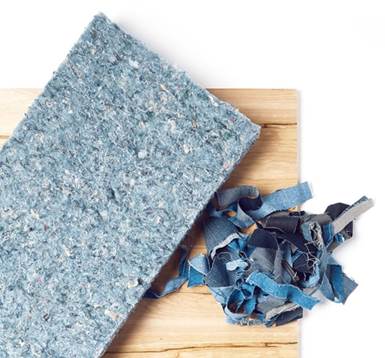Established in 2006 by Cotton Incorporated—a not-for-profit organisation that aims to support the global cotton industry—the Blue Jeans Go Green denim recycling programme is a great industry-wide sustainability initiative.
A quick and shocking Google search says that around the world, about six billion pairs of jeans are produced each year. That being a lot, inevitably some of these pairs also end up in the world’s whopping reportedly 16 million tonnes of textile waste—also each year.
How can we save jeans from the landfill?

Luckily, a division of the US-based cotton denim industry is trying to combat some of its waste with an initiative known as Blue Jeans Go Green. BJGG collects used or leftover cotton denim and recycles its natural cotton fibres into building insulation, which is then used to help with building efforts around the country. It appears old jeans can continue to keep us warm even after they’ve left our closets.
BJGG’s concept is that cotton is a sustainable fibre that, unlike other apparel materials, can be broken down to its natural state and transformed into something new. This current “something new” (in quotes to say, ‘we look forward to continued innovation!’) is called UltraTouch Denim Insulation. It’s made by Bonded Logic, Inc, a US-based manufacturer of several thermal and acoustical insulation products for multiple industries.
Its UltraTouch product boasts:
•Environmentally safe, non-itch insulation
•No carcinogenic warnings, formaldehyde, or chemical irritants
•Extraordinary thermal performance
•30 per cent better sound absorption than traditional fibreglass insulation
•Containing active mould/mildew inhibitor
Sounding great, for being made of jeans!
Where is this insulation actually getting used?
A portion of it has contributed to 40 Habitat for Humanity affiliates around the country; other portions are used in civic buildings. Habitats for Humanity and organisations with a licensed architect, contractor, or builder are eligible to apply for the Blue Jeans Go Green UltraTouch Denim Insulation Affiliate and Grant Programs.
How does the denim get collected?
First, BJGG has made recycling an easy “chore” by partnering with Zappos For Good. Through this programme, all anyone needs to do is box up their old denim, sign in to a Zappos or Amazon account, print a shipping label, and send it on its way by dropping it at a local UPS store. (Continental US shipping only)
The initiative is also working with 81 colleges and universities to get students to recycle their denim. Alternatively, in grassroots efforts, they encourage textile recycling enthusiasts (or anyone curious!) to host denim drives. What’s that? As explained on the website, “educators, students, professionals, volunteers, or anyone interested in making a difference is invited to collect their community’s denim and collectively send it to BJGG. Whether it's in your neighbourhood or at the office, every effort and piece of denim collected makes an impact.”
However, one thing to note is that the denim needs to be at least 90 per cent cotton. This is usually the case with jeans, but with polyester so popular and prevalent, one should check the content of their stretchy skinny jeans before assuming they can be recycled—I didn’t reach out to ask, but it could be that one polyester jean could ruin an entire batch of recycled cotton. Additionally, sent-in jeans must be removed from any attached hangers, tags, stickers, or plastic.

So far, the Blue Jeans Go Green initiative has been able to:
•Divert 1950 tonnes of denim from landfills
•Recycle 3,900,000 pieces of denim
•Produce 7,000,000 Ft2 of Ultra Touch Denim Insulation
A number of brands, including Industry Standard, Levi’s, InJeanius, Madewell, and ONS, also actively partner with BJGG to reduce their waste. Wrangler, for example, worked with the company to recycle its denim by-products from its manufacturing process and distribution centres.
So who’s behind this?
Blue Jeans Go Green was established in 2006 by Cotton Incorporated, a not-for-profit organisation founded in 1970 to support the global cotton industry. Cotton Incorporated is funded by US cotton growers and importers and we use those funds for research and development, and promotion of cotton. Its mission is to increase the demand for and profitability of cotton—and its mission for BJGG is to consider the movement for a greener world through educating and empowering individuals and organisations to extend cotton denim’s life (and cotton’s, therefore) by recycling it into something new.
The goal being, it seems, to keep the industry alive for the wellbeing of those who work in it, but to offer a way for its excess product to be used for good and for other purposes.
The ultimate goal?
Perhaps—ideally—to have all cotton denim recycled, and perhaps for all housing insulation to be made from recycled denim. Sending in our jeans is a small step for us, but collectively it makes for a very big leap toward a more circular future.
This article has not been edited by Fibre2Fashion staff and is re-published with permission from synzenbe.com







Comments